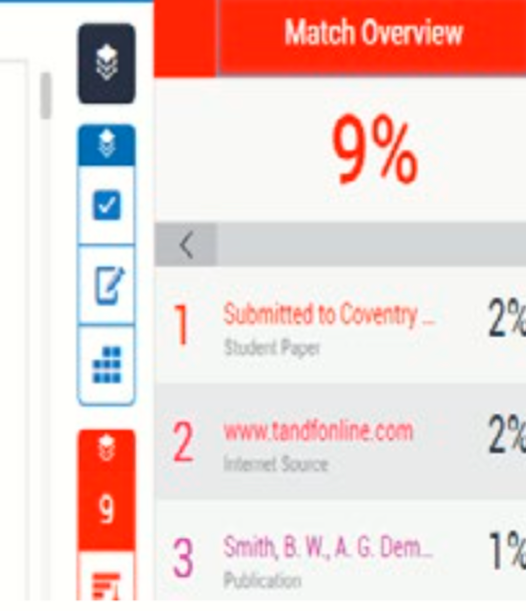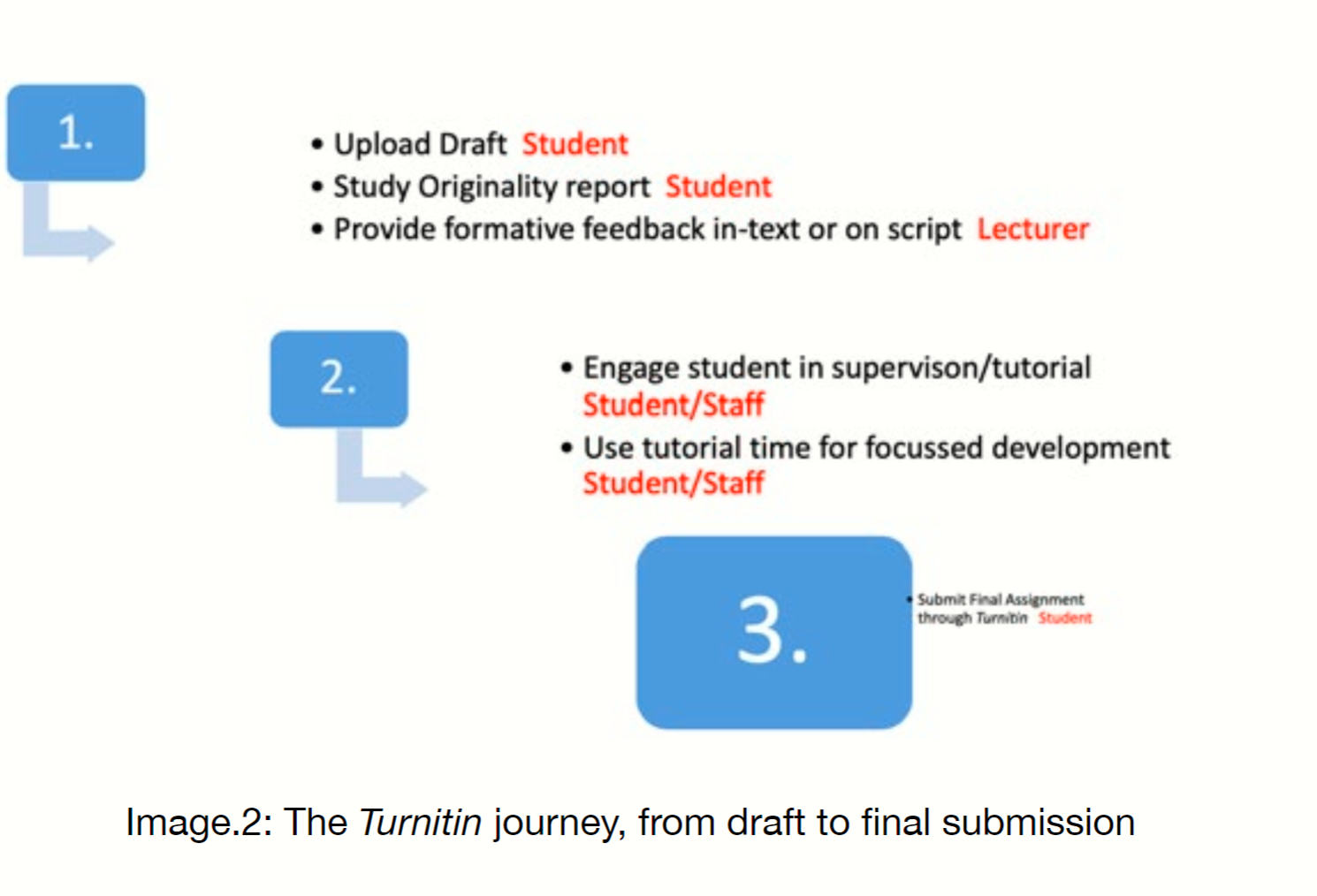Using Turnitin as a Positive Tool for Formative Assessment
Ref: https://acdev.orgdev.coventry.domains/application/files/2715/6293/3552/J282-19_The-Coventry-Way-eBook_V7.pdf [accessed 26.10.20]
Aims and rationale:
The use of Turnitin as a tool within Higher Education has been growing for many years. Alongside this, however, a culture of fear has been growing among students that they will somehow be caught out by the software and vilified as a cheat. This case study aims to challenge that culture and offer some insight into how Turnitin can be used as a positive tool for both staff and students. Through proper understanding of Turnitin and its intended use, staff and students can begin to use Turnitin to self-assess, to make academic improvements, and to send and receive appropriate formative feedback throughout modules and courses.
Implementation:
Turnitin for staff is a tool that we often only use to mark electronically. It is the GradeMark software that allows us to do just that, and not Turnitin itself. There is, as with most software, a period of training and practice that is required for us to fully understand the enormous capabilities of Turnitin and just how positive a tool it can become when embedded as part of our formative assessment processes. As there is some training needed, there is a requirement for us to set aside time to practice. However, that training need be no more than a few hours or a couple of working lunches; it is the practise that counts most. The implementation of Turnitin only requires a little extra planning and nothing more. No additional materials are required, and logistically, Turnitin will save time in the long run, improving tutorials and supervisions as well as the academic work that is submitted as part of the summative assessments. Turnitin in the right hands is a win-win for staff and students.
It is essential to remember a few golden rules when working with Turnitin within any module. For example, ignore the numerical score: this is the percentage shown at the top of the report (see Image.1 below). Turnitin isn’t, and never has been a tool for detecting plagiarism.

‘The rapid growth in the market for such software is premised on the misconception that it identifies plagiarism’ (Mphahlele and McKenna 2019: 2).
Turnitin simply matches text found in an assignment to text found electronically. It does not recognise in-text citations or direct quotation marks.
When you start to look into the history of Turnitin, you realise that it does not detect plagiarism and this is something that is noted throughout the resources on the Turnitin webpage itself. Turnitin is a text-matching software, and the score tells us what percentage of the writing has been matched to other sources online/electronically. This is very important to understand.
‘The Turnitin originality report shows the paper’s text highlighted with any text that matches sources found in the Turnitin databases containing vast amounts of web content, previously submitted papers, and subscription-based journals and publications’(turnitin.com/resources2019)
Understanding that Turnitin does not detect plagiarism and that a student can have a very high score but equally has referenced everything correctly (very often found in research modules) leads us towards being able to integrate Turnitin into the inner workings of our modules. We get to a place where it can become a positive tool for students and staff.
‘So does Turnitin detect plagiarism? No — Turnitin offers a tool that helps educators (and their students) make informed evaluations of student work rapidly and move on to the important task of discerning what their students need in the way of instruction, correction or judicial action,’ (turnitin.com/resources 2019)
Tutorials/Supervision:
1. Create your Turnitin links before the start of your module and hide them from students’ view.
2. Create another two draft Turnitin links for say, Coursework 1 and Coursework 2, which are visible to your students before the start of your module.
3. Before any supervision or tutorials (at CU Scarborough this is usually week 3 and week 6 of a module) ensure that your student has submitted their draft work and that you have taken a few minutes to scan the work. You may want to add some comments in-text, or at the top of the page.
4. Your tutorial should then focus on how the student might use your formative feedback to make improvements. This is where you save time – you should be able to talk with a specific focus rather than sit reading a student’s draft during the tutorial. Essentially your student receives double the amount of formative feedback (written and verbal).

‘…our results demonstrated that using Turnitin as a formative writing tool, allows students to prepare an assignment in an academically acceptable way… with less plagiarism’ (Halgamuge 2017: 895).
Feedback from students:
‘It is so much easier to see where I miss citations when Turnitin highlights them.’
‘I wish every tutor gave us formative feedback through Turnitin.’
Reading the Turnitin Report – before final submission:
1. Your students should have been taught how to read their report (this may be done in addition to class time or during a module induction).
2. The score (percentage shown at the top of the report) is arbitrary and should be ignored when using the report to improve academic writing and referencing.
3. Diligently check each of the matched text sources that are highlighted by Turnitin. This is something that students should be taught to do as part of their self-assessment and as part of the editing process for their summative assessments. Staff may consider a spot-check approach to this task by randomly selecting the sources, either as part of the formative or summative assessment.
4. Turnitin will highlight any matched text, and so students should be able to identify where quotation marks are expected to be and where citations should be included.
Paraphrasing – an unexpected improvement:Poor paraphrasing is often where students fall, and where, in some institutions, students race through the academic integrity disciplinary procedures. At CU Scarborough, our graduates go on to other institutions for their postgraduate study and so it is imperative that we are confident in their ability to use Turnitin effectively.
Poor paraphrasing is usually an issue in the first year of undergraduate study, primarily down to schools accepting loosely paraphrased work without any citations needed. It can be tricky for students to break the habits they have been forming over the past 10-12 years in other areas of education, and so Turnitin can become irreplaceable.
Through the active and regular use of Turnitin, students can learn to improve their paraphrasing skills by following these simple steps, followed by submission through the draft Turnitin link on their module:
• Read the section of the textbook/article and make notes.
• Close the book or cover the article and paraphrase the notes that were taken.
• Take a break – go for a walk – make a coffee – change the music…
• Now paraphrase the first paraphrase
• Now paraphrase your paraphrase
Students should be submitting a paraphrase that was written three times. Their Turnitin report will highlight any sentences or sections that are matched against online electronic sources, and they can continue to work on the paragraph until they have expertly written a paraphrased paragraph. It is this paragraph that the students should be citing.
Advantage = citations are accurate, and the paragraph is not plagiarised (or a direct quotation)
Disadvantage = students must break the habit of relying on the original text and therefore, must begin to understand what they have read
Clearly, as academic staff, we can see the advantages of following the advice above; in fact, we may wish all of our students would undertake this use of Turnitin as they are drafting work. We are reliant on students seeing the benefit of this process, and so it is often down to how enthusiastic the staff are and just how embedded Turnitin is within our modules.
Student feedback:
‘I wish we had been taught how to paraphrase this way from the start [of the course].’
‘It seems so easy when you break it all down to [the] steps [listed above].’
Positive outcomes: Benefits to using Turnitin throughout a Module:
1. Improved academic writing grades after students use Turnitin to draft summative assessments.
2. Improved paraphrasing.
3. Better use of time during tutorials, with more open discussion and improved focus.
4. Opportunity for tutors to give targeted formative feedback electronically.
5. Students’ ability to self-assess before submission and target weaker areas such as paraphrasing and citation.
6. Reduced marking time for staff, as students will have effectively used their Turnitin report.
Plagiarism is a topic that is discussed repeatedly throughout modules and courses, across each phase and level and throughout a student’s academic career. Detecting plagiarism is the responsibility of a tutor and a keen eye can detect plagiarism in its most complicated form without the help of any type of software. It is unfortunate that Turnitin has become synonymous with plagiarism detection because as we know, Turnitin only matches text – it does not recognise quotation marks or accurate citations.
If academic staff can be trained in the proper use of Turnitin they can then share that knowledge with their students early on in the students’ academic journey, enabling them to assess their own strengths and weaknesses, identify areas of good academic writing, and areas that they need to work on before submission. Students can prepare for tutorials effectively and therefore conversations can be targeted and developed.
‘…about half of the participating students who had used (Turnitin) reported that this software helped them improve their referencing skills, and quite a few of them talked about improved writing skills in general. What is interesting about this study was the adoption of (Turnitin) not only as a plagiarism-detection tool but as a teaching tool to help students avoid plagiarism. By sharing originality reports with students and discussing with them ways to avoid plagiarism, students were able to improve their writing in general and referencing skills in particular.’ (Ayon 2017: 2)
With the correct knowledge and training Turnitin can be a positive tool for improved academic success and for staff, Turnitin can improve opportunities for formative assessment and change attitudes towards this outstanding piece of software.
References:
Ayon, N.S. (2017) ‘Students’ and Instructors’ Perceptions of Turnitin: A Plagiarism Deterrent?’. Creative Education 8(13), 2091 -2108
Halgamuge, M.N. (2017) ‘The use and analysis of anti‐plagiarism software: Turnitin tool for formative assessment and feedback’. Computer Applications in Engineering Education 25(6), 895-909
Mphahlele, A. and McKenna, S. (2019) ‘The use of Turnitin in the Higher Education sector: Decoding the myth’. Assessment & Evaluation in Higher Education 1-11. DOI: 10.1080/02602938.2019.1573971
Turnitin.com (2019) Higher Education [online] available from <https://www.turnitin.com/divisions/higher-education>%5B1 May 2019]
Turnitin.com (2019) Resources [online] available from <https://www.turnitin.com/resources> [1 May 2019]
Additional resources
Bruton, S. and Childers, D. (2016) ‘The Ethics and Politics of Policing Plagiarism: A Qualitative Study of Faculty Views on Student Plagiarism And Turnitin®’. Assessment & Evaluation in Higher Education 41(2), 316-330
Jameson, S. (2016) ‘Leeds Beckett University’s Holistic, Institutional Approach to Academic Integrity’. Journal of Perspectives in Applied Academic Practice, 4(2), 71-72
Khoza, S.B. (2015) ‘Can Turnitin Come to the Rescue: From Teachers’ Reflections?’, South African Journal of Education 35(4)
Ransome, J. and Newton, P.M. (2018) ‘Are we Educating Educators about Academic Integrity? A Study of UK Higher Education Textbooks’. Assessment & Evaluation in Higher Education 43(1), 126-13
About the author:
Chelle Oldham is a tutor in Early Years, ITE, Education and Childhood Studies. Currently supporting supervision for number of Higher Education Institutions whilst completing a PhD. Before this, she was Head of Department for Teacher Education at Cumbria University. She spent five years at Leeds Met (now Leeds Beckett) University where she was Course Director, Teacher Fellow and one of the first Academic Integrity Officers trained to support faculties across the institution with cases of plagiarism and implementing the university regulatory process. It was whilst in this post that Chelle began to run professional development activities for staff in how, Turnitin could be promoted to students as a positive tool for improved academic success.
Key words: Turnitin, referencing, GradeMark, academic integrity, academic ethics, plagiarism

Leave a Reply
You must be logged in to post a comment.